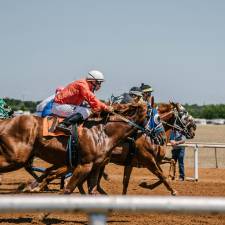
By Tom Keegan
Question: What’s even more cringe-worthy watching people blush after working oneself into an embarrassing situation with all the world watching?
Answer: Watching them not blush because they don’t know enough to be embarrassed.
Face it: The thoroughbred horse racing industry is led by a series of committees under the umbrella of organizations identified by acronyms consisting of yes men and women nodding their heads in agreement because it’s easier to get through the day that way.
Industry leaders should be mortified that for the second time ever and first since 1968, the Kentucky Derby winner could be on the verge of being stripped of its title over what appears to be a technicality.
Guess again. Instead, the attitude seemingly can be summed up in 10 words: “A rule is a rule is a rule. So there.”
Nobody said those exact words, but they might as well have in trying to explain how it is that Bob Baffert, the most successful thoroughbred trainer of the 21st century, was suspended for two years by Churchill Downs and then, reflexively, by the New York Racing Association before a thorough investigation was conducted into what happened that led to Derby winner Medina Spirit to flunk a post-race drug test because it had a small amount of betamethasone in its system.
How small an amount? This small: .21 picograms per milliliter of blood. A picogram is a trillionth of a gram. For comparison purposes, consider that a human being who is found to have less than 300 nanograms of cocaine per milliliter of blood passes the drug test and is allowed to fly an airplane. A nanogram is one billionth of a gram.
If you just accepted a job offer pending your passing a drug test, you wouldn’t want horse racing standard applied by the employer. Let’s say you win $20 on a golf wager and unbeknownst to you your victim earlier in the day had rolled up that bill and used it to snort a line of cocaine while using the bathroom at the turn.
The trace of the devil’s dandruff makes its way onto your hand. You rub your nose. It’s in your system. Sorry, you just lost your new job and it’s too late to go back to your old one.
It’s for scenarios such as those and countless others that the threshold for human testing allows for contamination levels. Not horse racing, where the intent of the drug-testing rules and regulations–protecting horses from trainers who mask lameness by injecting horses with corticosteroids within 14 days of a race–are pure, but the practical implementation of them opens the door to unintended consequences.
Denial of Due Process
Baffert, naturally, filed a lawsuit charging that he was denied due process.
Lawsuits make people nervous, especially people who could be deposed, placed under oath, and compelled to tell the truth by penalty of perjury. The truth just might expose horse racing’s drug-testing system as unrealistic, shallow and not based on thoroughly vetted research.
So it would seem leaders in the industry will be watching very closely in the event words are uttered in a courtroom that could make regulators realize there just might be a better way of doing things.
Guess again.
In order to fix a problem, you must first acknowledge you have one.
Dr. Mary Scollay, executive director of the Racing Medication and Testing Consortium in Lexington, said she doesn’t feel compelled to follow the trial closely, just in case she could learn something that might improve the system.
“No, I’m quite confident with the regulations that we’ve got and I’m confident with our testing capabilities,” Scollay said in a telephone interview. “I don’t have any uncertainty about that.”
Nothing to discuss here. The drug-testing system in horse racing is perfect. Everybody can go back to work now, except you, Mr. Baffert. You go back to your penalty box for two years.
Baffert maintains that the betamethasone came from an ointment called “Otomax,” to treat Medina Spirit’s skin irritation. The industry offers no guidance on the withdrawal time needed to avoid a positive drug test. California veterinarians operate with the understanding that one day is all that’s needed. Baffert said that the horse was treated daily up until a day before the Derby.
Even Scollay acknowledged that Baffert might have had no idea that his team was putting Medina Spirit at risk of flunking a post-race drug test. “I can certainly see it as a mistake,” Scollay said. “I mean, assuming the horse was treated topically, you know, I could believe that it was a mistake, sure.”
How unfortunate that a Kentucky Derby outcome could be changed over such a mistake, no?
“All mistakes are unfortunate,” Scollay said.
Mistake or otherwise, Medina Spirit had 21 picograms of betamethasone per milliliter of blood in its system.
“At the end of the day, the rule does not afford mitigation away from the disqualification,” Scollay said. “You can mitigate any kind of sanction to the trainer, but you can’t mitigate away from the fact that the substance is prohibited and it was detected in the sample.
That’s a binary: It’s either a yes or a no. Mitigation applies to sanctions that might be applied to the trainer. How did it get into the horse? Why did it get into the horse? Could it have been prevented? Blah, blah, blah. Those sorts of things. Lack of intent doesn’t make the finding go away.”
If the leaders of the industry spend the next 20 yards picking eggshells out of their eyebrows, they can’t say they weren’t warned about the dangers of low thresholds.
Dr. David Nash, a Lexington-based veterinarian whose background includes working as an equine veterinarian and then as a researcher for major pharmaceutical companies, recalls having been called in to meet with newly elected Kentucky Gov. Matt Bevin’s transition team six years ago.
“I’ve been dealing with this nonsense for a long, long time and it’s really screwed up,” Nash recalled telling those picking his brain. “And I also warned them, and I warned everybody else, including Churchill Downs, that trying to fix these problems would likely lead to more problems, including a drug positive of a low level in the Kentucky Derby. Boy, I was wrong about that one, right?”
The warnings led to no changes, and here we are.
Veterinarian Dr. Clara Fenger, a board-certified equine internal medicine specialist and Secretary of the North American Association of Racetrack Veterinarians, said that at an ARCI model rules meeting 15 days before the Derby won by Medina Spirit, she shared with everyone in attendance research that she had hoped would lead regulators to up the threshold from a no-tolerance policy to 100 picograms, since that level could be attributed to contamination, and that it would take at least 300 picograms to mask lameness.
Fenger said that one of the higher-ranking officials in the room told her: “There is no stomach to raise the thresholds."
Looking back on that, the simmering Fenger said: “So the science, the fact that we could demonstrate these things, that didn’t matter to him. No stomach? I’m not sure what that means. Who’s stomach are we talking about?”
Interestingly, Fenger also pointed to a study that she said proves that betamethasone is “piss-poor at masking lameness. So the argument that their reason why we’re restricting the use of this drug is so that people won’t be injecting joints, well, you could inject it on race day and you’re not going to mask pain.
It’s just not good at that. Its beneficial effects are considerably more subtle. It’s honestly a much better drug as a topical (for skin irritations) than it is as a joint injection.”
When Scollay was asked if she could point to the published, peer-reviewed study that led to placing restrictions on betamethasone, she made a stunning revelation.
“No. Those results were not published,” she said.
Why is that? Is it because there were not enough horses in the study to pass a peer review?
“No, ultimately, it came down to the principal investigator who was responsible for submitting a manuscript for publication failed to do so, and you can’t write a paper for somebody else,” Scollay said.
So the researcher trusted to publish the results of the study betrayed that trust, yet the findings nevertheless were so trusted by the organization that paid the bill that they led to a disputed result in the Kentucky Derby and a two-year suspension for the most familiar face in horse racing.
Again, stunning. “This individual just didn’t do it,” Scollay said. “We have adjusted our funding structure so that you don’t get the final amount of funding until you have submitted a manuscript to a journal and it’s under review.”
That’s too late to prevent the credibility of the rule in question from being questioned.
It’s too early to predict where this is all headed, but the odds-on-favorite would be Medina Spirit getting stripped of its title.
Dancer’s Image flunked a post-race urinalysis in 1968 and lost the Derby title. Late attorney Ned Bonnie represented the horse’s handlers in court and ultimately lost, but emboldened other horsemen to pursue legal action. According to his understudy, Kentucky attorney Joel Turner, Bonnie was fond of saying: “The regulators are shooting at rabbits while the lions are eating the natives.”
Asked to apply that sentiment to what’s happening today, Turner obliged: “The regulators are catching the trainers who make stupid mistakes. They are taking down the low-hanging fruit without much effort, instead of focusing on those trainers everyone suspects are using illicit designer substances and other performance-enhancing compounds to win big races and pocket large purses with impunity.”
It’s difficult to deny that the system is broken, and it doesn’t look as though it will be fixed from the inside. Again, fixing a problem requires knowing you have one.
There are other informative articles in our section on Horse Racing.
© 2021 Equine Info Exchange, LCC All Rights Reserved.
This article was published on Equine Info Exchange on August 12, 2021.
Copyright Notice
All material appearing on www.EquineInfoExchange.com (“content”) is protected by copyright under U.S. Copyright laws and is the property of Equine Info Exchange, LCC. You may not copy, reproduce, distribute, publish, display, perform, modify, create derivative works, transmit, or in any way exploit any such content, nor may you distribute any part of this content over any network, including a local area network, sell or offer it for sale, or use such content to construct any kind of database. You may not alter or remove any copyright or other notice from copies of the content. Copying or storing any content is expressly prohibited without prior written permission. For permission to use the content, please contact info@equineinfoexchange.com.













